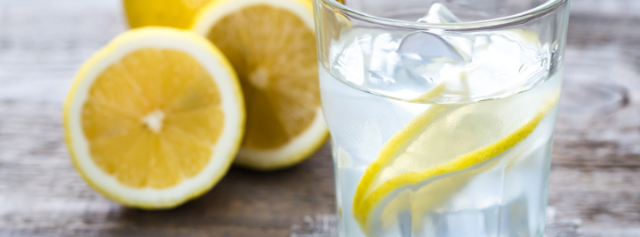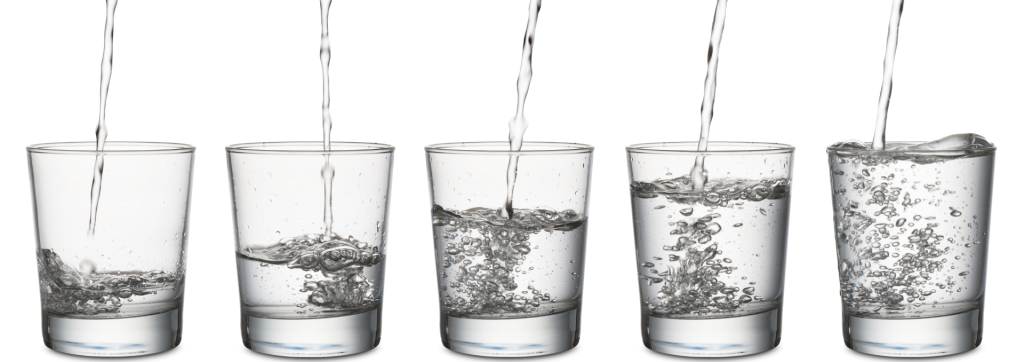Keeping well hydrated is a basic foundation of maintaining good health, yet it is often overlooked—to detriment.
As a functional health coach and cognitive behavioral coach, I have had clients tell me that they “forget” to drink water because they are “too busy”.
Or, that they don’t like the taste of water and, instead, drink “sports drinks”, like Gatorade and Powerade; flavor-infused bottled waters; or powdered drink mixes like Crystal Light.
Or, they misunderstand what “hydration” means and assume that drinking any fluid counts as hydration. For example, one 61-year-old woman told me when we started working together that she drank maybe 1 glass of water daily—if that (!)—but that she felt well “hydrated” because she drank coffee all day, as well as soda, up until the time she went to bed!
Or, they do not realize how important it is to support the kidneys and liver with proper hydration when taking multiple medications. I’ve worked with people who take up to 20 medications daily—and may only drink 2-3 glasses of water (total) for the day.
Why hydration matters
Up to 75% of Americans are chronically dehydrated.
This matters because, overall, the body is composed of 60% water (NOT Gatorade, Powerade, Crystal Light-infused water, coffee or cocktails!), with 75% in the muscles and 85% in the brain. The body weight of babies is comprised mostly of water (75%); and, in the elderly, water comprises apx. 55% of body weight (1).
Over time, chronic dehydration can contribute to:
- Lower blood volume in the body, which then manifests as low energy and lethargy.
- A slower metabolism and weight gain.
- Constipation, across all ages and especially with the elderly (2).
- Impaired cognitive function that affects concentration, alertness and short term memory (3).
- High blood pressure.
- Urinary tract infections.
- Exercise-related asthma.
- Increased sugar cravings.
- Joint pain.
- Ulcers.
- Kidney disease.
How much water is enough?
Drinking enough water is vital for your body to function optimally.
A general guideline: drink half your body weight in ounces.
For example, if you’re 150 pounds, aim to drink 75 ounces of water (that’s apx. nine 8-ounce glasses of water) daily. You may need to drink more if you have engaged in vigorous or long-duration exercise, spent hours in the heat, or consumed caffeine or alcohol, both of which have a diuretic effect and make you pee more (women are especially susceptible). When you are well hydrated, your pee should be virtually clear or a very pale straw yellow.
The National Academies of Science Engineering Medicine recommends that women drink 2.7 liters (91 ounces) and men drink 3.7 liters (125 ounces) water daily, sourced from all beverages and foods (4).
Isn’t feeling thirsty the best way to tell if we need to drink water?
Feeling thirsty is not always a reliable signal of needing to drink more water.
Especially for older adults (and even if you are not). Take note if you are 60 years of age or older! Studies have shown that aging 1) causes changes in overall body water composition; 2) can adversely affect renal function, which often declines; and 3) alters the perception of thirst, which, on average, declines among older adults (5).
Renal function, by the way, refers to how well your kidneys work to remove waste and extra water from the blood—as urine. Your kidneys also help maintain electrolyte balance and produce hormones that regulate blood pressure.
Unfortunately, among older adults, dehydration is not only common, but can have serious consequences, including poor mental/cognitive function; susceptibility to infectious diseases; kidney stones; thrombosis, which occurs when a blood clot forms inside a blood vessel and obstructs the flow of blood; and obstipation, when you are unable to pass stool or gas (6).
Regardless of age, dehydration is a physiological stressor. And, a stressed-out body will produce more stress hormones. Hydrating well throughout the day is key to having stable energy and keeping stress hormones at a tolerable level. Begin drinking water from the time you awaken until 2 to 3 hours before bedtime.
Ideally, drink filtered tap water or water from a glass bottle to minimize exposure to plasticizers, like phthalates and bisphenal-A (BPA); both are endocrine disruptors, meaning they disrupt hormone function. Phthalates and BPA are all also classified as environmental obesogens and linked to increased risk of obesity (7,8). Microplastics, or plastic particles, in bottled water are another consideration. A 2018 study that analyzed 293 bottled waters found that 93% of the bottled waters contained microplastic particles (9).
On hot and/or humid days when you are physically exerting yourself or engaging in intense exercise for long periods of time (over an hour), you will also want to be mindful of electrolyte balance when you hydrate. An electrolyte imbalance can trigger symptoms that range from mild to severe.
Experts disagree on whether it’s better to drink cold, warm or room temperature water. Ayurvedic or Traditional Chinese Medicine practitioners advocate drinking warm water because your cells absorb it more easily. Personally, I have found that my body is more receptive to warm or room temperature water. While drinking ice cold water can feel like much-needed cool relief on a hot, humid summer day, it “shocks” my system more, and I find myself unable to drink as much water as I need to properly hydrate.
DIY “Flavored” Waters
I’ve worked with clients who tell me that they don’t like the “taste” of plain water, so they will flavor their water with commercial flavored powders, like Crystal Light and Propel. These brands may offer “sugar-free” options. But while “sugar” may not be technically listed as an ingredient, artificial sweeteners, like aspartame or sucralose (Splenda) and artificial food colorings—both of which have been linked with an increased risk of cancer—are.
If you don’t like the “taste” of plain water, you can enliven it with natural whole food flavorings, such as sliced lemon, lime, strawberries or other fruit, cucumber, or herbs, like basil and mint.
Leafy greens are a high-water food. Another option is to have a green smoothie, like this Detox Spinach-Pear Smoothie. A green smoothie should consist mostly of leafy greens with a bare minimum of fruit and blended with filtered water (versus a plant-based mylk, like almond or oat) to maximize its hydrating effect.
For hydrating refreshment, try these naturally flavorful, caffeine-free herbal teas—warm or cold.
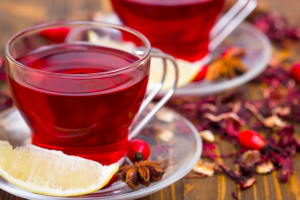 Hibiscus Tea: Hibiscus is a plant known for its beautiful, colorful blooms. The flower and leaves can be made into a tea or extract. In hot weather, hibiscus tea is refreshing; it has a lip-puckering tart, yet sweet flavor. Though it can be sweetened with raw honey and/or sliced fruit, I prefer drinking it unsweetened. Caffeine-free hibiscus is mineral-rich (calcium, magnesium, iron, phosphorus, potassium, sodium and zinc) and a good source of vitamin C and antioxidants. It is also a natural diuretic. Health benefits associated with drinking hibiscus tea include its ability to potentially lower blood pressure, lower cholesterol, improve immune health, provide relief for urinary tract infections, and raise metabolism, enhancing weight loss (10). As delicious and refreshing as hibiscus tea is, DO NOT drink if you are pregnant (hibiscus can stimulate menstruation or premature labor), taking hormone replacement therapy or oral contraceptives; or, if you are taking medication for high blood pressure (11). Hibiscus does interact with some medications, so check with your doctor first.
Hibiscus Tea: Hibiscus is a plant known for its beautiful, colorful blooms. The flower and leaves can be made into a tea or extract. In hot weather, hibiscus tea is refreshing; it has a lip-puckering tart, yet sweet flavor. Though it can be sweetened with raw honey and/or sliced fruit, I prefer drinking it unsweetened. Caffeine-free hibiscus is mineral-rich (calcium, magnesium, iron, phosphorus, potassium, sodium and zinc) and a good source of vitamin C and antioxidants. It is also a natural diuretic. Health benefits associated with drinking hibiscus tea include its ability to potentially lower blood pressure, lower cholesterol, improve immune health, provide relief for urinary tract infections, and raise metabolism, enhancing weight loss (10). As delicious and refreshing as hibiscus tea is, DO NOT drink if you are pregnant (hibiscus can stimulate menstruation or premature labor), taking hormone replacement therapy or oral contraceptives; or, if you are taking medication for high blood pressure (11). Hibiscus does interact with some medications, so check with your doctor first.
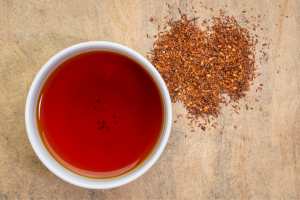 Rooibos Tea. This distinctly “red” tea is grown mostly in the Western Cape of South Africa. Naturally caffeine-free, rooibos is loaded with antioxidants, including two, in particular—nothofagin and aspalthin—that can help reduce stress hormones, like aldosterone and cortisol. It’s also a good source of minerals, like calcium, potassium, magnesium, iron, sodium and zinc, which gives it an astringent zingy flavor. Click here for my Rooibos Tea recipe.
Rooibos Tea. This distinctly “red” tea is grown mostly in the Western Cape of South Africa. Naturally caffeine-free, rooibos is loaded with antioxidants, including two, in particular—nothofagin and aspalthin—that can help reduce stress hormones, like aldosterone and cortisol. It’s also a good source of minerals, like calcium, potassium, magnesium, iron, sodium and zinc, which gives it an astringent zingy flavor. Click here for my Rooibos Tea recipe.
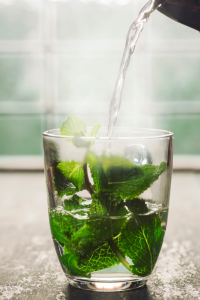 Mint tea: The mint family, which also includes peppermint and spearmint, belongs to the genus mentha. It’s cooling, refreshing and detoxifying, whether you drink it hot or cold. Fresh mint, which I prefer to use in my tea, is widely accessible—you can find it at the grocery store or farmers’ markets. Simply place fresh mint teas in a teapot or mug, add boiled hot water and steep for 5 to 10 minutes.
Mint tea: The mint family, which also includes peppermint and spearmint, belongs to the genus mentha. It’s cooling, refreshing and detoxifying, whether you drink it hot or cold. Fresh mint, which I prefer to use in my tea, is widely accessible—you can find it at the grocery store or farmers’ markets. Simply place fresh mint teas in a teapot or mug, add boiled hot water and steep for 5 to 10 minutes.
What’ is your favorite way of hydrating?
Sources:
1, 3 Nutrition Reviews. 2010 Aug; 68(8): 439-458.
2 European Journal of Clinical Nutrition. 57, S88–S95 (2003).
4 National Academies Sciences Engineering Medicine. 2005.
5, 6 Medscape: Geriatrics and Aging. 2007;10(9):590-596.
7 Fundamental and Clinical Pharmacology. 2017 Dec;31(6):594-609.
8 Annals of Pediatric Endocrinology and Metabolism. 2014 Jun; 19(2): 69–75
9 Frontiers in Chemistry. 2018; 6: 407.
10 Organic Facts.
11 Medline Plus.

